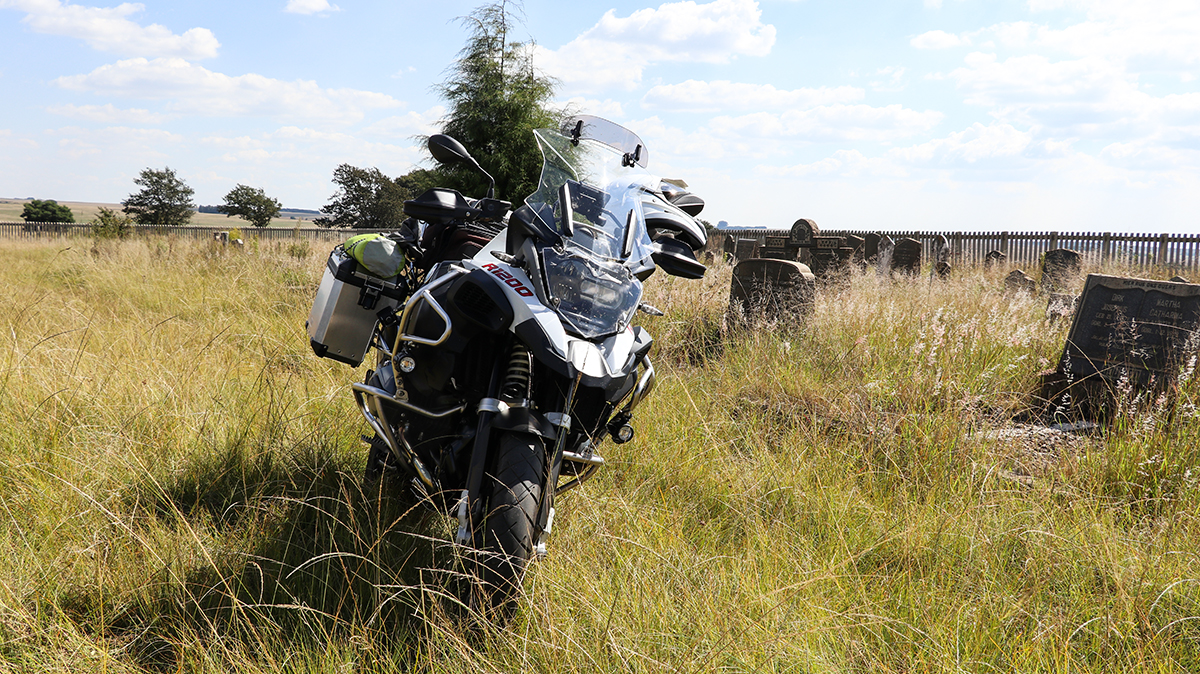
Mpumalanga, or ‘ET’, as it is affectionately known by motorcyclists, is an area endowed with spectacular scenery and sweeping mountain roads, the best of which is the legendary ‘22’, between Sabie and Hazyview. Over the years that I have ridden out east, I have been way too destination focussed. The fact that the roads favour spirited riding hasn’t helped much. If like me, you tend to focus on the road rather than on the scenery, you end up missing out on a lot of interesting historically significant sites. This Easter I decided to cruise east and take in some fascinating Anglo-Boer War sites which I have researched and which really got me thinking about what went down in this area in the early 1900s.
I packed the GS and rode east under an azure sky, with occasional clouds like tufts of candyfloss. The first stop was adjacent to the Balmoral off-ramp, about 30 kays before Witbank. There is an old, overgrown cemetery, next door to a recently opened Anglo/Boer Restaurant, which sports some great Boer war murals. The dilapidated state of the graveyard is exacerbated by the immaculately trimmed lawns around the eatery. I grabbed my camera and strolled through the cemetery, allowing my mind to wander and contemplate the events that had caused the death of the almost 200 souls buried there.
Flyback with me in time. When the old Transvaal Republic was forced into declaring war on Britain on the 11th October 1899, the British public expected it to be all over by Christmas. There was no way, they mused, that a bunch of peasant farmers could take on the might of the most powerful empire in the world at that time. By the end of January 1900, a scant four months later, instead of celebrating victory, the Empire was drenched in mourning. Battles fought in Natal at Nicholson’s Nek, Talana, Colenso and Spionkop and in the Northern Cape at Belmont, Graspan, Modder River, Stormberg and Magersfontein saw 5,575 British troops killed, wounded or captured. The dream of a quick victory evaporated like mist under the harsh African sun. The ‘peasant farmers’, by contrast, had suffered a loss of 1156 men. The Empirical greed was being paid for with the blood of its fine young men.
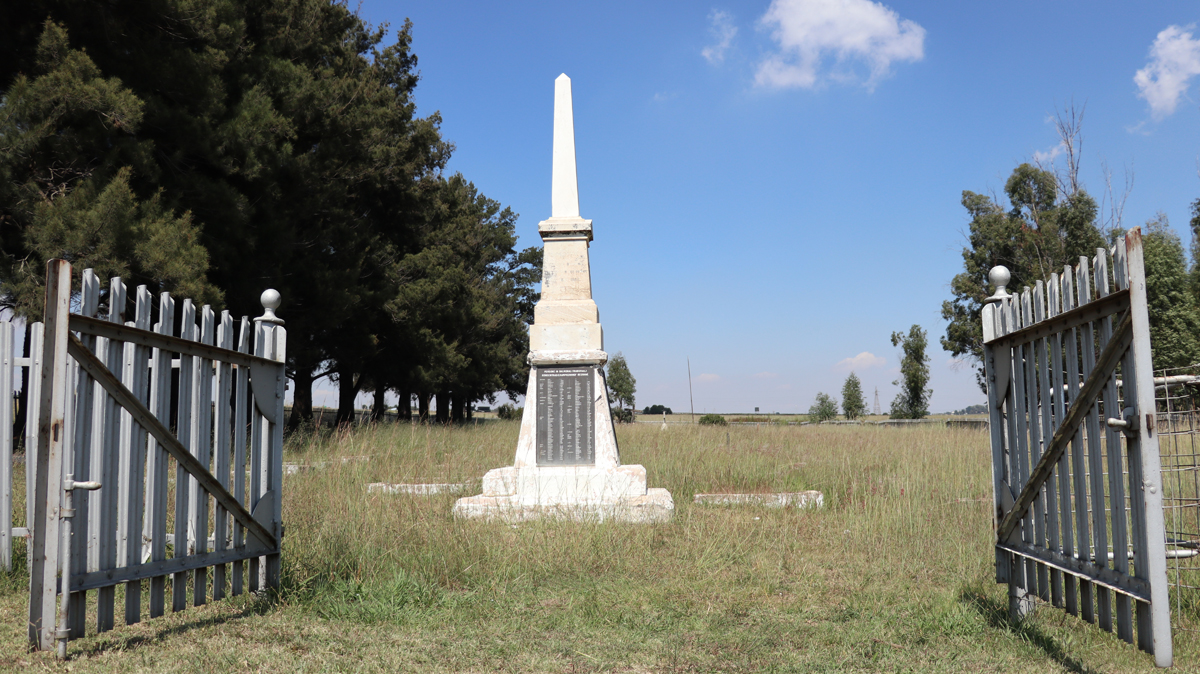
By the end of 1901, Lord Kitchener had determined that the only way to defeat the Boers, who were now waging a guerrilla war against the ponderous British military with great success, was by employing the now-infamous “Scorched Earth Policy”. By herding the Boer women and children into concentration camps and burning their farms and killing their livestock, they would prevent the re-supply of the roving Boer Commandos. The unsanitary camp conditions decimated the imprisoned women and children. By the end of the war, 26251 souls, of which 80% were children, had succumbed to disease. Boer combatants who were killed or died on active service numbered less than 7000.
Reading the names on the memorial at Balmoral is really moving. The number of young and infant children buried there is heart-rending. The peaceful, serene environment was totally at odds with the tears shed at this site. In some cases, the whole family was eradicated. The menfolk who survived the war returned to devastated lives where everything that they held dear was ripped from them, both materially and emotionally. I got a glimpse into the psyche of this proud, headstrong nation that has always paid a huge price for its freedom. They have suffered unspeakable misery, yet have shown the resilience that can only be born out of a deep faith in their God. Who knows how the current chapter in the history of these people will unfold?
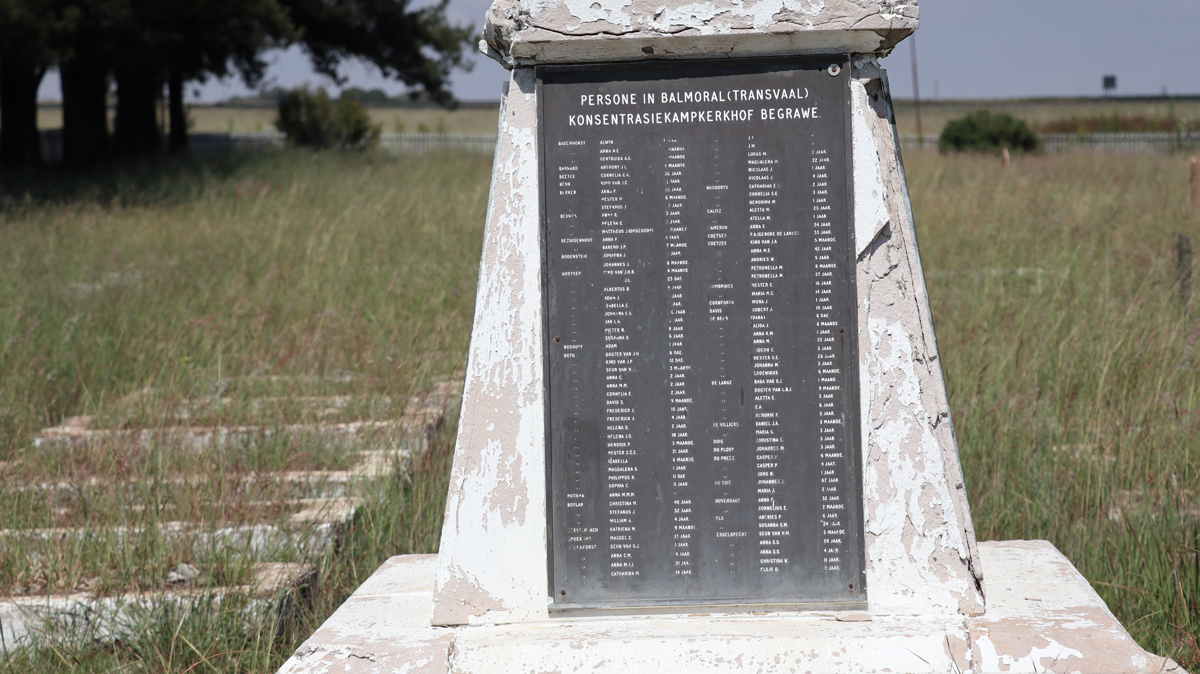
It was with more than a hint of melancholy that I climbed back on the Bee Emm and headed off to the quaint little historic town of Chrissiesmeer, where I was to witness evidence of an enduring story of devotion. Travel to Carolina and beyond, on the road to Swaziland and just outside of town, you will hang a right to Chrissiesmeer, some 24 k’s down a beautifully scenic road traversing undulating hills. There were many skirmishes around this area, as well as a pitched battle fought in February of 1901. This tale had its origin in a fierce skirmish in the October of 1900. A certain Lt. Arthur William Swanston, of the Inniskilling Dragoons, was killed whilst trying to save the lives of some of his men, and in particular, a Private J. Garlick. A private memorial was erected by Swanston’s parents and brother officers. The cemetery is on a gentle hillside overlooking the lake from which Chrissiesmeer gets, in part, its name.

Every year from 1901, a small box arrived in late September, containing a sprig of heather, bound in alternate years with pink and blue ribbon and addressed to The Postmaster, Chrissiesmeer. A brief note asked that the heather be placed on the grave of Lieutenant Swanston. Every year, without fail, the little box arrived, to be faithfully placed on Arthur’s grave by the current Postmaster. It was only in 1957 that a little light was shed on the matter. The then Postmistress, Tannie ‘Rensie’ Kruger, received a letter which she read with some difficulty. The sender revealed that she was Lt. Swanston’s fiance’ and that he was her one true love. She never married and in 1957 was in poor health, so was not sure how long she could keep sending the annual sprigs of heather. Two years later, 60 years after the Lieutenants death, the last box arrived. Tannie Rensie attested to the fact that, to the best of her knowledge, every box arrived undamaged and found its way onto the grave of Lt. Swanston. Quite remarkable, considering the bad feeling resulting from the Scorched Earth policy, which resulted in enduring Boer bitterness. I guess there is truth in the statement, that love does indeed, conquer all!
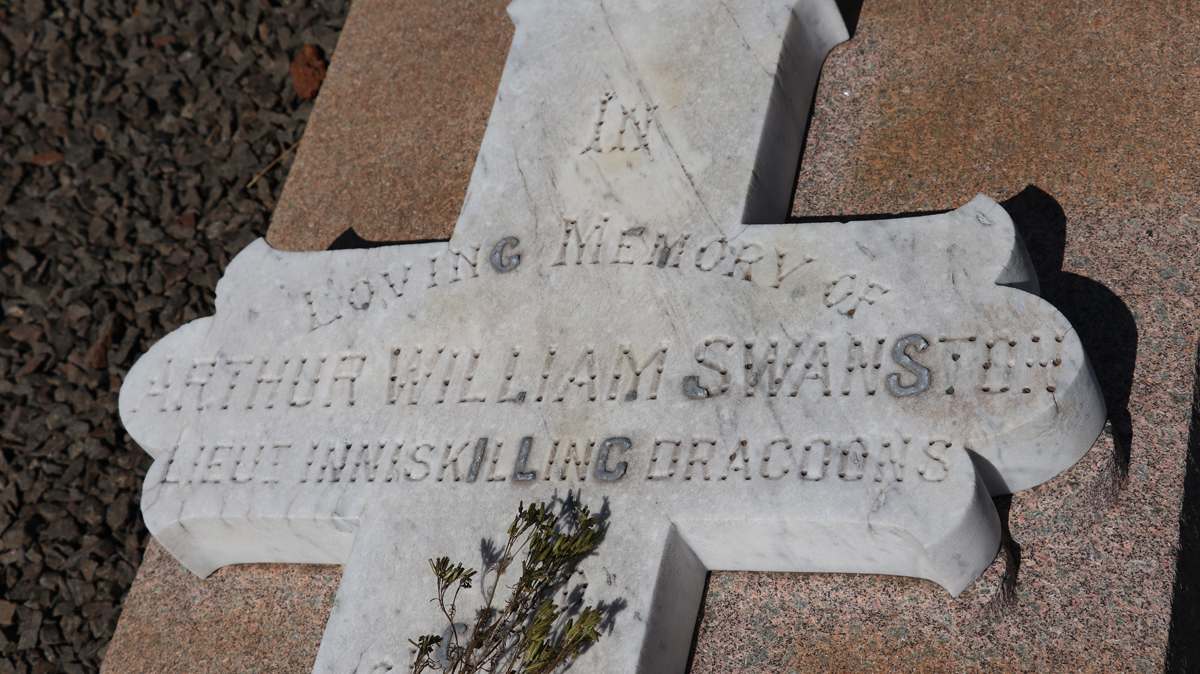
My mood was somewhat lighter when I rode out of town, back to the N4 and past the turn-off to Belfast, to the impressive Bergendal Memorial on the right-hand side of the road. This was the scene of the last pitched battle of the Boer war. General Redvers Buller, bringing his army up from Natal, joined forces with the main British army under Lord Roberts, or ‘Bobs’, as he was referred to by his men, advancing along the railway line between Pretoria and Portuguese East Africa. The Boer commander, Commandant General Louis Botha, holding a line along the escarpment, chose this site to impede their progress. With a combined Empire force of around 22000 and almost 100 cannon, against, at best, 5000 Boers with a couple of cannon, the outcome of the battle was pretty certain.
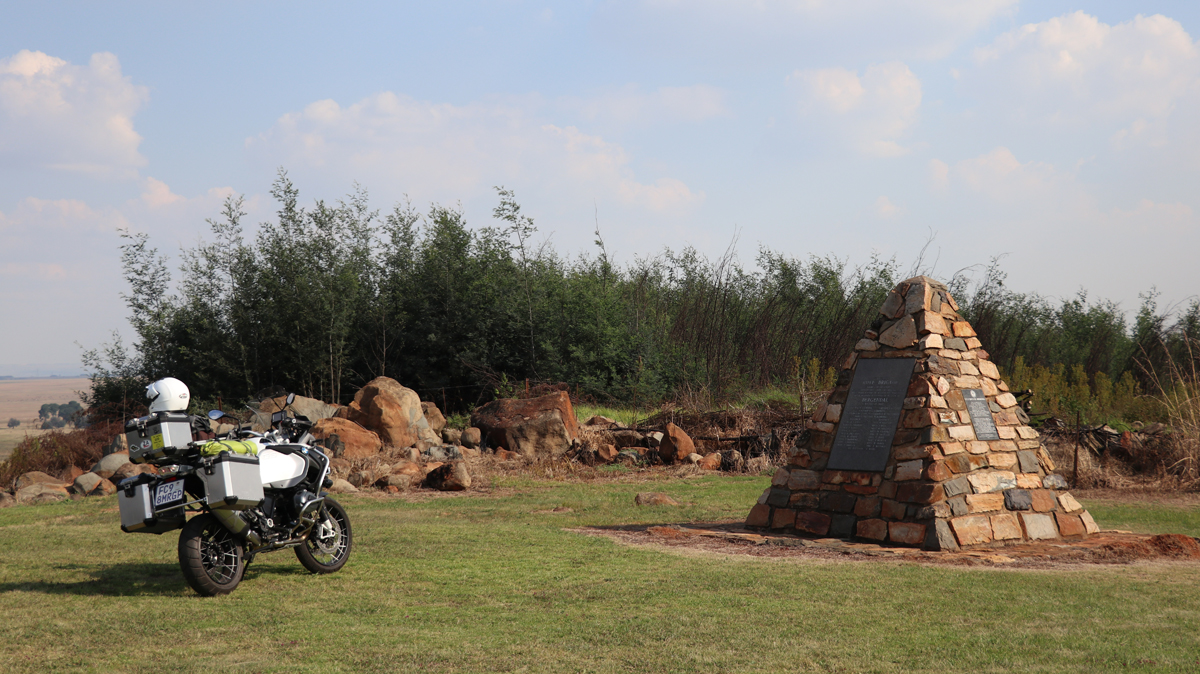
Some distance to the rear of the Boer force, a solitary Long Tom cannon, from which the pass gets its name, hurled a few shells at the advancing Brits. The Boer marksmen wreaked some havoc on the enemy, resulting in the Brits withdrawing and simply shelling the unfortunate Boers into submission. The Boers retreated down the hill, hopped on their horses and lived to fight another day. This did give rise to another tale.

By this stage of the war, the Boers had been in the field for so long, without any means of re-supply, that many were barefoot and literally clothed in sacks. An enterprising Boer whipped the boots off of a fallen foe and rode off appropriately ‘reshod’. Later that night, when stopping for a quick forty winks, he took off the boots. This surprised his mates, who always slept in their shoes to facilitate a quick escape if necessary. Asked why he hadn’t kept them on, he rather superstitiously said that he was just a bit concerned that the previous owner may come to claim them back while he slept!

As you enter the town of Machadodorp, just after the popular stop at Milly’s, you will find an old cemetery where most of the British fallen were interred. Taking some photos of the metal crosses, it was disturbing to see a number without names, but rather the inscription “Unknown soldier of the British Forces”. The full horror of war gets driven home. Some soldiers being marred beyond recognition by shelling, ending up in an unknown soldiers grave, their families informed that they were “Missing in action, presumed dead”. The lack of certainty allowing the flame of hope to flicker uncertainly for a while… It was then back on the bike to Dullstroom, and the end of my first day of ghost hunting. I booked into the Dullstroom Inn. After what had turned out to be a long and strangely emotional day, I shelved my camping plans in favour of an ice-cold beer and a soft bed. Getting soft, Dave, getting soft!

I sat on the veranda, sipping a bitterly cold one and watching the setting sun bathe the old sandstone church on the opposite side of the road in a beautiful, golden glow. Come to think of it, there is a story that concerns that old church too. The church fell into disrepair and the Boers caught wind of some alleged Boer traitors that were living in the partial ruin and passing information concerning the location of Boer commandos in the area to the British. A Boer officer, curiously named ‘Roksak’ Redelinghuys, dressed in a British officers uniform, infiltrated the town and visited the church posing as a ‘Colonel Bullock’, in order to expose the traitors. Redelinghuys got the nickname when his comrades learnt that he carried one of his wife’s dresses in his pack, as a reminder of home and family. He was accompanied by a fellow named Bester, who posed as a ‘Colonel Blood’. The ploy was a huge success, as the ‘Veraaiers’ gave the two ‘British Officers’ their valuables for safekeeping. Three men were subsequently arrested and sentenced to three months of hard labour by a Boer military court on 13th July 1901, which they largely dodged, by escaping from custody during an attack on the commando by the British, on the 29th July. This stage of the war saw a number of Boers changing sides as they began to realise the inevitable outcome of an unwinnable war. These ‘Veraaiers’ were despised by the ‘Bittereienders’ remaining in the field.

Early the next morning, in the deliciously fresh autumn air, I rolled out of town towards Lydenburg. Literally on the hill going out of town, on the left-hand side, there is a tiny cemetery against the hillside, just below a rebuilt stone fortification. You can open the farm gate at the bottom of the hill and then follow a jeep track right up to the gravesite. The view from the graves is spectacular. It reminded me very much of the Scottish Highlands, bedecked with a sort of vegetation which seems common to cool, misty climates. The rocky outcrop at the crest of the hill is covered with tufts of hardy grass, interspersed here and there with some magnificent Protea bushes. Like at Balmoral, in fact even more so, there was an almost eerie serenity about the graveyard. The sort of place where you find yourself talking in whispers. An ever so gentle cool breeze played over the hill, which was now saturated in the bright early morning sunshine. I set my bike on the side stand, took off my helmet and gloves and drank in the tranquillity of it all.

The little clump of graves is dominated by the marble headstone on the grave of Captain Angus Menzies, of the 1st Battalion, Manchester Regiment. The inscription reads: “Who was wounded in action near this spot on the 21st January 1902, and died on the following day”. Just behind him, with an equally impressive headstone lies a Major ATP Hudson, who “Was wounded in action at Elandspruit on the night of the 19th December 1901, and died on the following morning”. Around 14 men are buried there. Some of the final words of the famous ballade, The Scottish Soldier, came to mind as I surveyed the poignant scene.
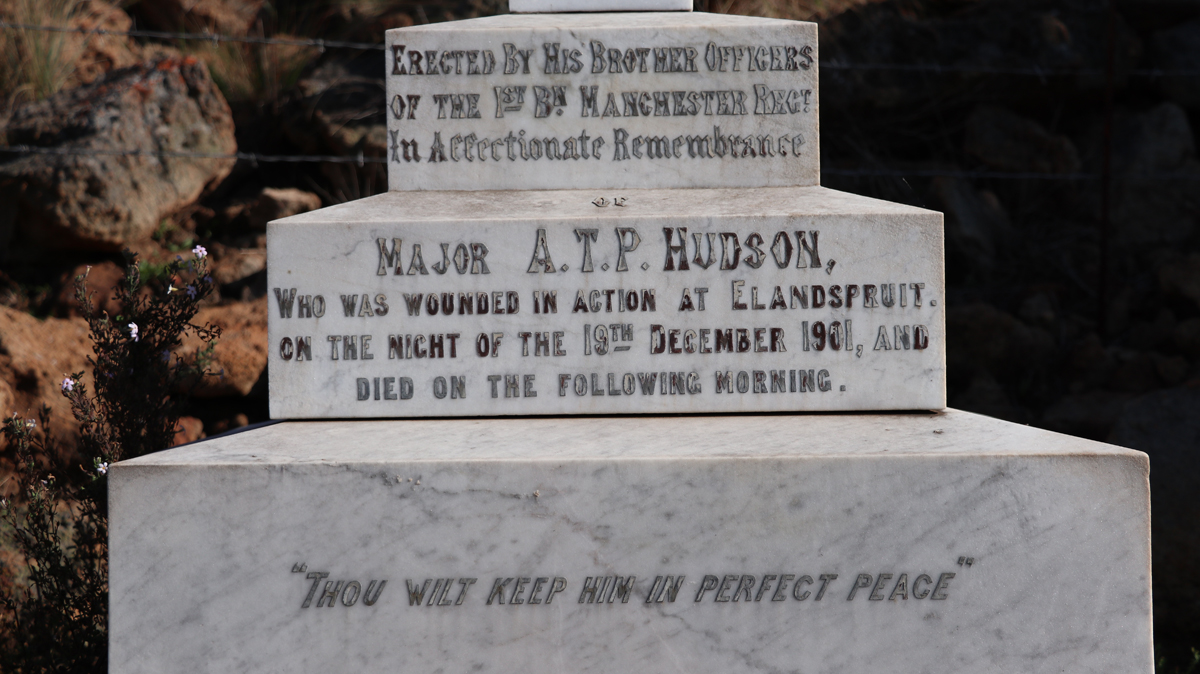
“And now this soldier, this Scottish soldier,
Who wandered far away and soldiered far away,
Sees leaves are falling and death is calling
And he will fade away in that far land.
Because these green hills are not my Land’s hills
And as far as these green foreign hills may be,
They are not the hills of home”.
Communication being sketchy back in 1901, I would imagine that when Major Hudson’s family sat down to Christmas dinner that year, they surely wondered where their valiant soldier son was, no doubt praying that he was well. Little did they know that their precious boy had bled and died on an obscure piece of African veld, less than a week before Christmas.
“And on a hillside, a Scottish hillside
You’ll see a piper play his soldier home”.
The bugles cease now, he is at peace now……….on a hillside near Dullstroom, far away from home.
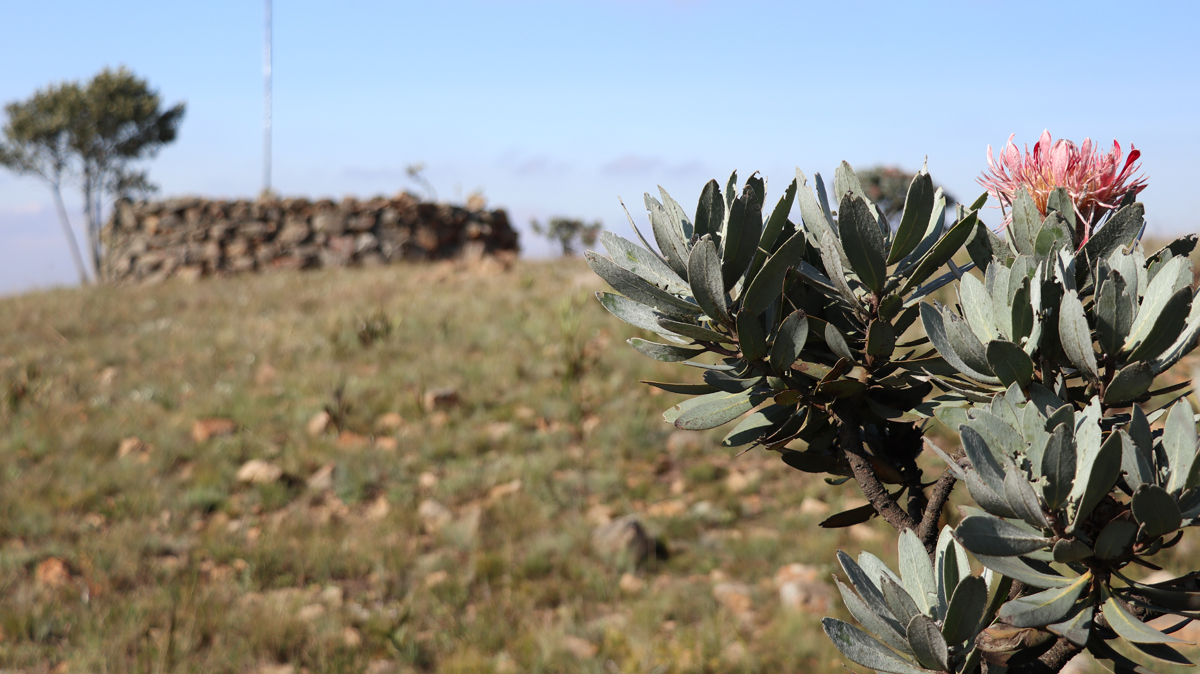
With a lump in my throat, I bid the brave men goodbye and rode slowly back down the hill and on towards Lydenburg, for my last haunting visit to some long-departed brave hearts. Travel on another few k’s and you will see another clump of war graves, also on the left-hand side, beside the road. At this scene, there was a short sharp skirmish on the night of the 9th December 1901. Again it was the 1st Battalion, Manchester Regiment in the thick of things. The night was very dark and misty. Three Boer commandos attacked the 1st Battalion (a mounted Infantry unit) simultaneously. In the ensuing confusion, 9 men of the Heidelberg Commando died, together with a similar number of troopers from the Manchesters. As you look diagonally across the road from the British graves, you can make out the monument to the fallen Boers. This action was recorded as The Battle of Ouhoutbossie.
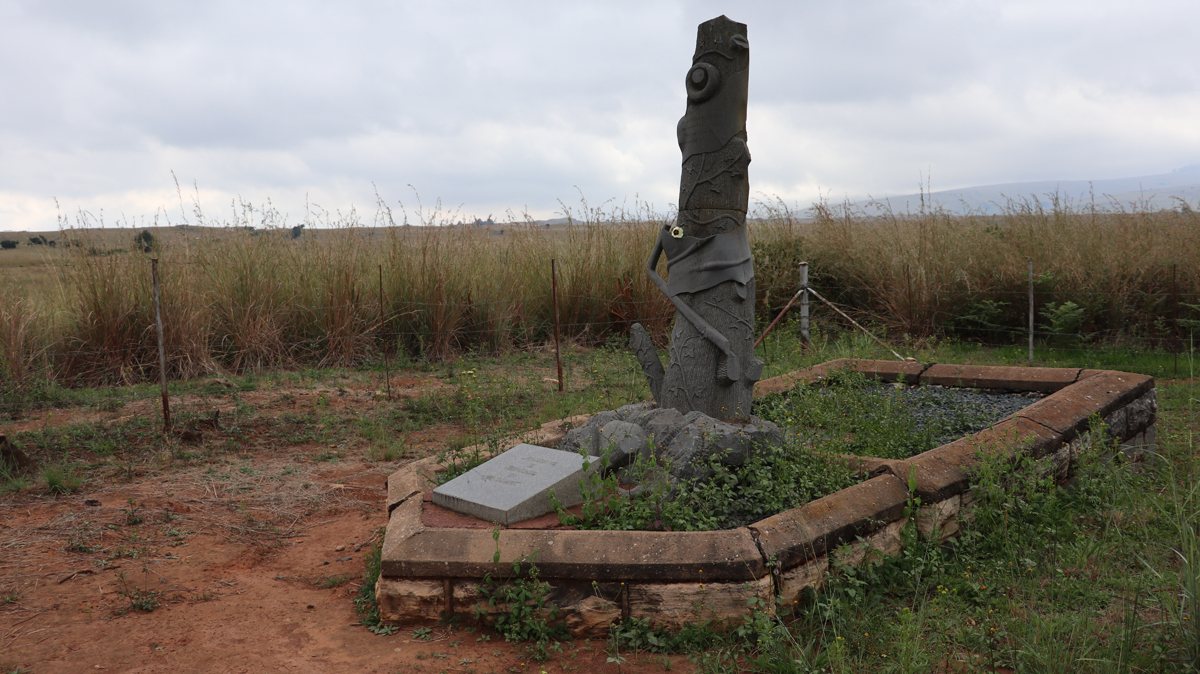
Maybe it is just me, but when I spend time at these sites and immerse myself in the rich history and consider how it must have been all that time ago, it is profoundly moving. It gets you thinking of the unspeakable misery that we have visited upon ourselves with countless wars fought over the ages. An example of the collateral damage that always happens in war is the equine devastation during what became essentially a ‘mounted’ war. The Boer horseman were arguably the finest mounted infantry that the world had seen. To counter their mobility, the Imperial Forces imported hundreds of thousands of horses from all over the world. The Boers mounts were hardy and could live off the land, whereas the Imperial horses died in their hundreds of thousands. Literally over half a million horses lost to war and disease. To what end? We rabbit on about the current pandemic, yet sacrificed over 22 million young men, in the prime of their lives, in the First World War. Supposed to be “the war to end all wars”, they were at it again just over 20 years later.
The Anglo/Boer war touched the furthest reaches of our land and had consequences that reverberate even today. When you ride your bike far and wide across our spectacular land, you will see constant reminders, if you know what to look for, of the small band of peasant farmers who defied an Empire for three years and were never defeated in the field. It was the carnage of the concentration camps that brought them in from the battlefield.
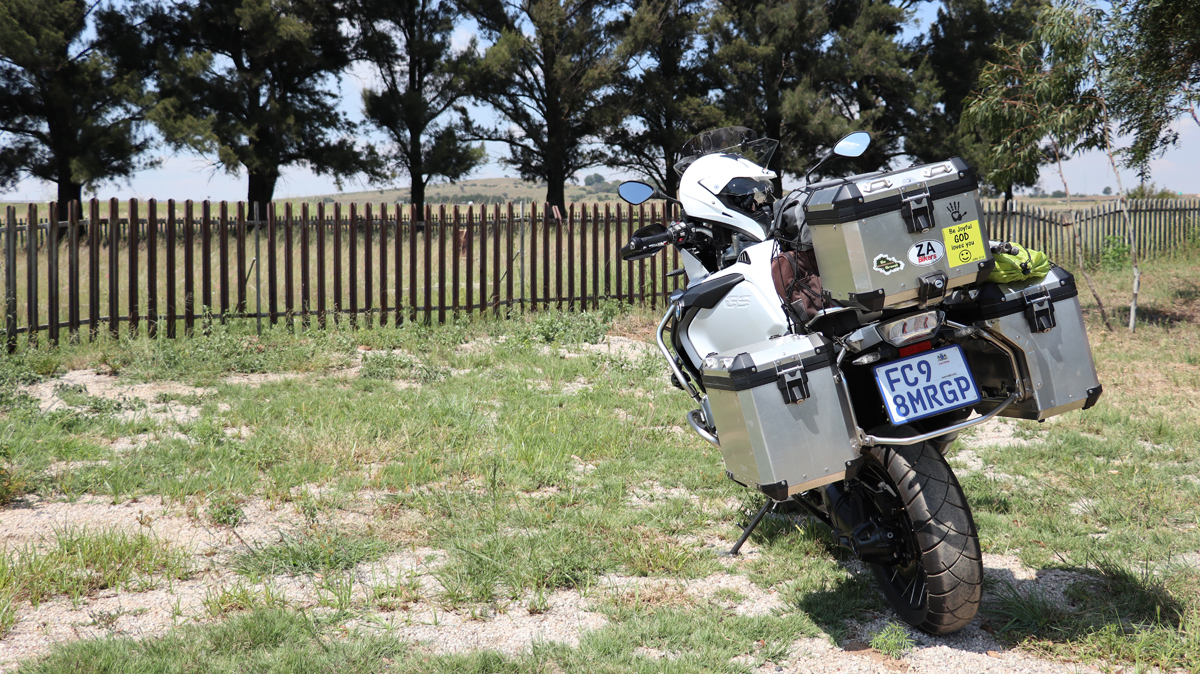
Do yourself, and your children, a favour and get a copy of a book that was invaluable in my research, called Anecdotes of the Anglo-Boer War: Tales from the ‘Last of the Gentlemen’s Wars’ by Rob Milne. It is an incredible and insightful read into a war that echoes throughout South African history even to this day. Your life is a blank tapestry and it is up to you to embroider it with a lifetime of rich experiences. Get to it, your bike is the needle and the road is the thread. For me, Rob Milne’s book provided the roadmap and inspiration.





